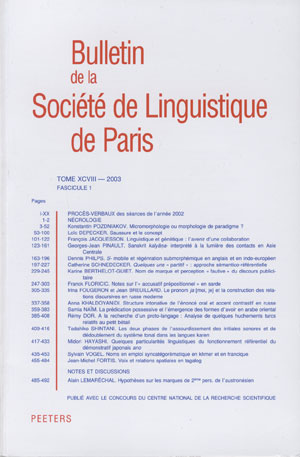 previous article in this issue previous article in this issue | next article in this issue  |

Preview first page |
Document Details : Title: Une petite grammaire de grand Subtitle: Pour une hypothèse unitaire concernant la classe des adjectifs en français Author(s): GOES, Jan Journal: Bulletin de la Société de Linguistique de Paris Volume: 114 Issue: 1 Date: 2019 Pages: 123-180 DOI: 10.2143/BSL.114.1.3287154 Abstract : L’histoire récente de la catégorie adjectivale en français moderne a été marquée par deux discussions cruciales concernant sa classification. Après la création de la catégorie du déterminant, on aurait pu croire que la catégorie de l’adjectif constituait une classe homogène; une première discussion (années soixante) a néanmoins abouti à la création de la sous-classe des adjectifs de relation, tandis qu’une deuxième discussion sur les adjectifs dits sans qualités (années deux-mille) a mené à l’identification des adjectifs du troisième type. Si ces recherches ont incontestablement contribué à une meilleure connaissance des adjectifs, elles ont également mené à une grande fragmentation en classes et sous-classes. Ainsi, il y aurait au moins trois types de grand: un adjectif qualificatif, un adjectif relationnel, et un adjectif du troisième type. Ce dernier serait encore à subdiviser en grand, adjectif d’intensité, grand, adjectif de mesure et grand, adjectif de quantification des traits. Il y aurait aussi un grand classifiant, voire un grand affectif. Nous avons pris cet adjectif comme objet pour effectuer une autre analyse: notre hypothèse fondamentale est que l’adjectif prend une grande partie de son sens du substantif qu’il qualifie. Ceci permet de constater qu’on a affaire à un seul adjectif grand, en différents emplois. Cette hypothèse unitaire nous a déjà permis de constater qu’un même adjectif dénominal comme royal est en emploi qualificatif ou relationnel selon le substantif support (le palais royal, un salaire royal); appliquée à grand, elle permet une analyse syntactico-sémantique plus fine, tout en gardant l’unité de la catégorie. Cette analyse nous permet aussi d’émettre des hypothèses plus générales concernant le comportement syntactico-sémantique des adjectifs en français. The recent history of the adjectival category in modern French has been marked by two crucial discussions concerning its classification: after the creation of the category of the determiner, one would have thought that the category of the adjective constituted a homogeneous class. A first discussion (in the sixties) nevertheless resulted in the creation of the subclass of relational adjectives, while a second discussion on the adjectives 'without qualities' (years two-thousand) led to the identification of adjectives of the third kind. While this research has undoubtedly contributed to a better knowledge of adjectives, it has also led to a great fragmentation into classes and subclasses. Thus, there would be at least three types of grand: a qualifying adjective, a relational adjective, and an adjective of the third kind. The latter would still be subdivided into grand, intensive adjective, grand, adjective of measure and grand, adjective of quantification of features. There would also be a grand classifier, even a grand affective adjective. We have taken this adjective as an object to carry out another analysis: our fundamental hypothesis is that the adjective takes much of its meaning from the noun it qualifies. This shows that we are dealing with a single adjective grand, in different uses. Our unitary hypothesis has already allowed us to note that the same adjective royal is in qualifying or relational use according to the substantive it qualifies (le palais royal, un salaire royal); applied to grand, this hypotheses allows a finer syntactico-semantic analysis while keeping the unity of the category. This analysis also allows us to make more general hypotheses concerning the syntactico-semantic behavior of adjectives in French. De recente geschiedenis van het adjectief in het moderne Frans is gekenmerkt door twee cruciale discussies over hun classificatie: na het ontstaan van de categorie van de determinant zou men gedacht hebben dat de categorie van het adjectief een homogene klasse vormde. Een eerste discussie (jaren zestig) resulteerde niettemin in de creatie van de subklasse van relationele adjectieven, terwijl een tweede discussie over de bijvoeglijke naamwoorden 'zonder eigenschappen' (jaren tweeduizend) leidde tot de identificatie van adjectieven van het derde type. Hoewel dit onderzoek ongetwijfeld heeft bijgedragen tot een betere kennis van adjectieven, heeft het ook geleid tot een grote fragmentatie in klassen en subklassen. Er zouden dus minstens drie types grand zijn: een kwalificerend bijvoeglijk naamwoord, een relationeel bijvoeglijk naamwoord en een bijvoeglijk naamwoord van het derde type. Het laatste type zou nog worden onderverdeeld in grand, intensief adjectief, grand, adjectief van maat en grand, adjectief van kwantificatie van kenmerken. Er zou ook een classificerende grand zijn, zelfs een grand emotioneel adjectief. We hebben grand als voorbeeld genomen om een andere analyse uit te voeren: onze basishypothese is dat het adjectief veel van zijn betekenis ontleent aan het zelfstandig naamwoord dat het kwalificeert. Dit laat zien dat we te maken hebben met één enkel bijvoeglijk naamwoord grand, in verschillende functies. Deze unitaire hypothese heeft ons al toegelaten vast te stellen dat hetzelfde denominale adjectief royal in kwalificerend of relationeel gebruik is in functie van het substantief dat het kwalificeert (le palais royal, un salaire royal); toegepast op grand, maakt deze hypothese een fijnere syntactisch-semantische analyse mogelijk, terwijl de eenheid van de categorie behouden blijft. Deze analyse stelt ons ook in staat om meer algemene hypotheses te maken over het syntactisch-semantisch gedrag van adjectieven in het Frans. |
|


